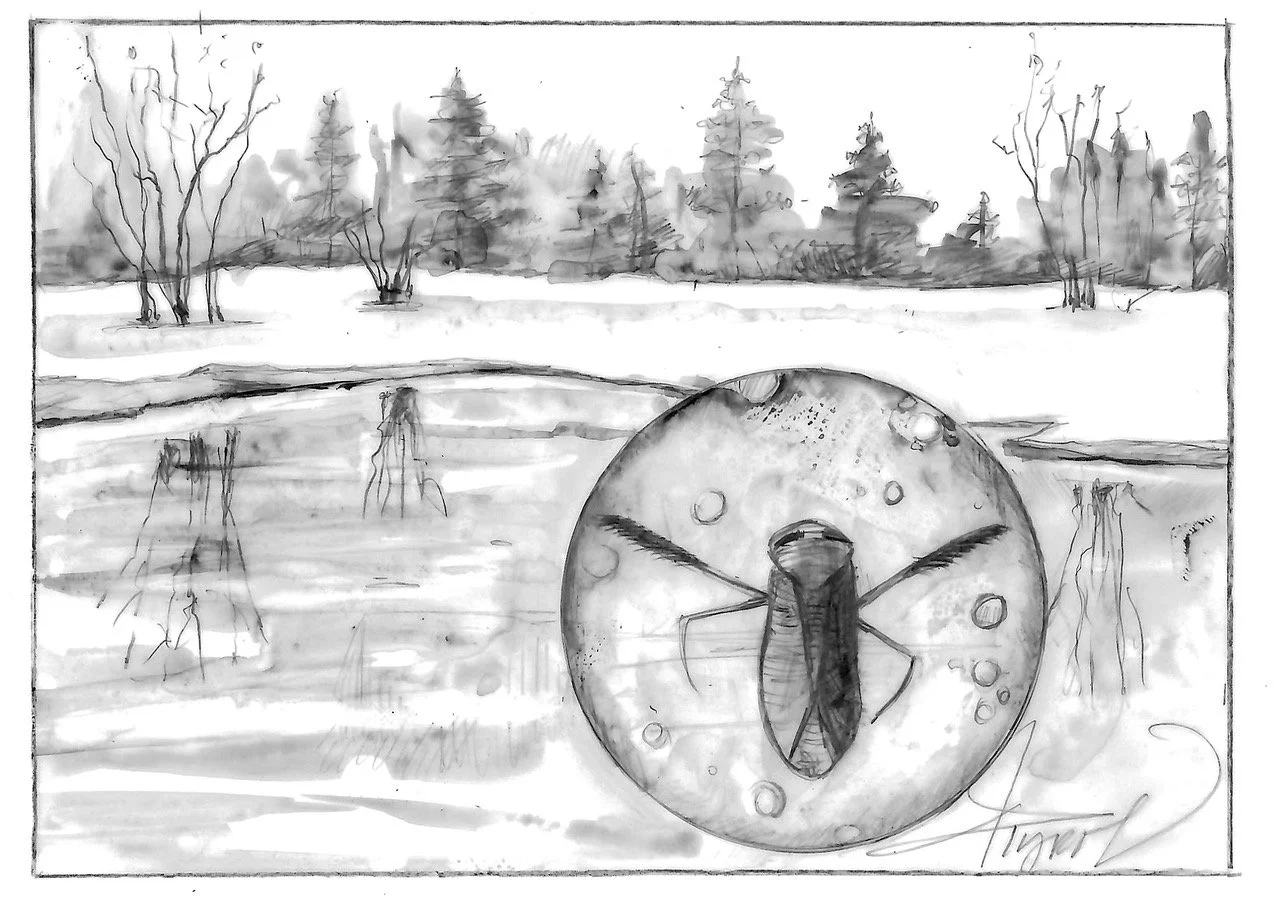The Outside Story: Water boatmen forage beneath the ice
Feb. 2, 2023 | By Declan McCabeIllustration by Adelaide Murphy Tyrol
If you get a chance this winter, take a peek through the icy window of a pond surface. You may see water boatmen – Hemiptera corixidae – clinging to the pond floor. Long oar-like hind legs propel these insects, inspiring their common name. Shorter, scoop-like front legs are used for feeding and singing.
This largest aquatic family of true bugs includes 128 North American species. Unlike their cousins the backswimmers which swim upside down, water boatmen swim with their winged dorsal surfaces facing up. When not swimming, they cling to submerged objects with their clawed middle legs.
They cling, because otherwise they bob up like corks, and it takes precious energy to swim back down. Buoyancy is a side effect of breathing: beneath their wings and abdomens, water boatmen carry bubbles, which act like tiny scuba tanks.
Fresh bubbles from the water’s surface contain 21% oxygen, the same as the air you and I breath. Over time, the insect uses up the oxygen, and the concentration drops. But oxygen from surrounding water continues to diffuse into the bubble, which functions like a gill. Absent ice, the insects surface for fresh bubbles. But in winter, they can remain submerged for extended periods as colder water holds more oxygen than warm water. Surprisingly, one North American species, Cymatia americana, can survive encased within solid ice.
Many water boatmen in small ponds and shallow wetlands, however, spread their wings and migrate before ice entombs them. Stephen Srayko from the University of Saskatchewan and colleagues have documented enormous corixid migrations from wetlands to larger rivers.
After migration, researchers found more than 200 water boatmen per square foot in slow-water locations. The scientists estimated that throughout the Prairie Pothole Region spanning three Canadian provinces and five U.S. states, 13,000 tons of water boatman biomass moves from wetlands to rivers. Srayko and his collaborators found that most fish sampled in these rivers dined on corixids, accounting for up to 97% of food consumed.
After overwintering in rivers, water boatmen returned to wetlands to feed and reproduce. Most water boatmen consume aquatic vegetation, but as many as a quarter of the North American species prey on invertebrates, including other water boatmen.
Some corixids generate sound announcing their presence to potential mates and rivals by rubbing file-like foreleg structures against a ridge called a “plectrum” on their cheeks. The sounds resonate through their air bubbles, and the size of the insect and its corresponding breathing bubble affects pitch; bigger bubbles produce deeper songs.
The sound of one European corixid in particular has attracted the attention of the folks at the Guinness World Records. The species measures 1/10 of an inch long and generates a 99-decibel sound that’s as loud as a passing freight train. Curiously, this species generates sound by rubbing a ridge on its penis against its abdomen, earning it the record for the loudest penis on the planet. Nature is stranger than fiction.
I was curious if corixid migrations to rivers happen in Vermont, so in January I grabbed a net and headed to the Winooski River. If vast swarms of water boatmen exist in the Winooski, they certainly eluded me. Despite several net sweeps from the bank, not a single water boatman revealed itself. I contacted Aaron Moore, who monitors river macroinvertebrates each fall for the Vermont Department of Environmental Conservation. He told me that they occasionally get water boatmen in samples, but not in numbers to suggest mass migration.
I had more luck locating corixids in a nearby wetland. After breaking through ice, my first net dip captured a water boatman. With or without a net, the best way to see water boatmen in winter is to approach a pond or wetland edge and look for movement as these insects go about the business of foraging beneath the ice. I find that tapping the ice surface encourages a bit of swimming.
Whether you knock on the icy door or not, I hope that you are lucky enough to see water boatmen in a pond near you. If you do, give a listen – they might even sing for you.
Declan McCabe teaches biology at Saint Michael’s College. His courses include Aquatic Biology, and a new course taught in the Dingle Peninsula called Coastal Biology of Ireland. The Outside Story is assigned and edited by Northern Woodlands magazine and sponsored by the Wellborn Ecology Fund of the New Hampshire Charitable Foundation.

